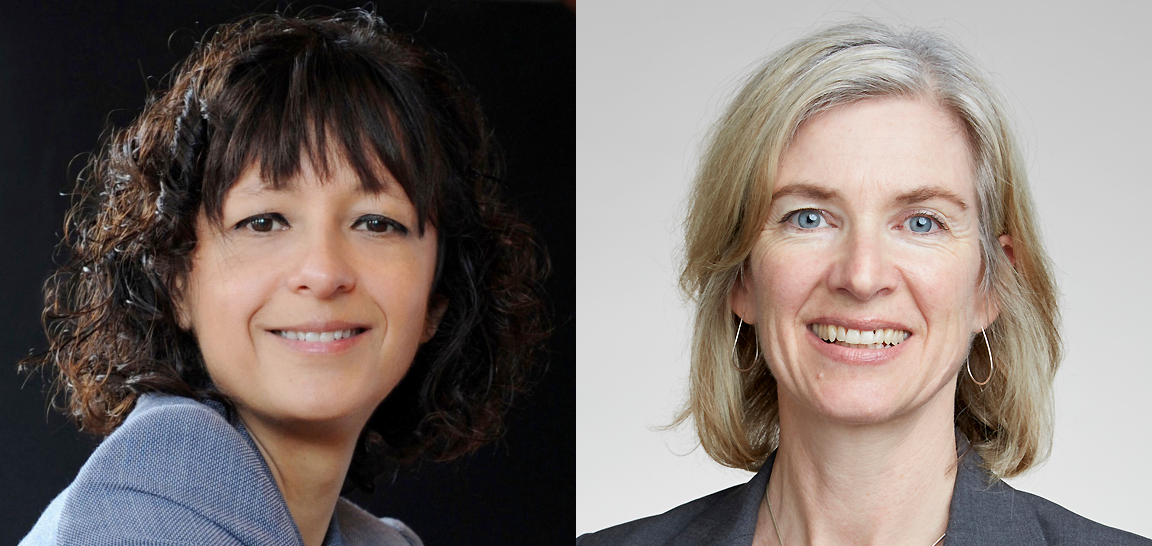
October 9, 2020, by Brigitte Nerlich
CRISPR, the Nobel, and women in science
I wrote my first blog post about CRISPR, gene editing or genome editing on 24 March 2015. It was entitled “From recombinant DNA to genome editing: A history of responsible innovation?” And I have written quite a few more blog posts about this new biotechnology since then. I knew that sometimes in the distant future somebody would get a Nobel Prize for gene editing but I didn’t think that would happen quite so soon. It has happened now.
In that first post I said: “The controversial cutting and splicing technique is called CRISPR, which stands for: Clustered Regularly Interspaced Short Palindromic Repeats. (And as a social scientist, not a biologist, I find it quite difficult to get my head round it) The acronym was first used in 2002 and CRISPR was first shown to work as a genome engineering/editing tool in human cell culture in 2012 (wiki). Two scientists in particular have been involved in developing a variant of this technique: CRISPR-Cas9 (and here on YouTube). They are Emmanuelle Charpentier, an immune biologist who works at the Helmholtz Centre for Infection Research at the University of Braunschweig and Jennifer Doudna, a specialist in molecular and cell biology at UC Berkeley (see their article in Science, 2014).”
Jennifer Doudna and Emmanuelle Charpentier were jointly awarded the Nobel Prize in Chemistry on 7 October 2020. This is fantastic news!
Doudna is currently Chair Professor in the Department of Chemistry and the Department of Molecular and Cell Biology at the University of California, Berkeley. Charpentier is now Director at the Max Planck Institute for Infection Biology in Berlin. In 2018, she founded an independent research institute, the Max Planck Unit for the Science of Pathogens (see wikipedia).
Awarding the Nobel in chemistry to these two scientists does not mean that others who have worked on CRISPR might not feel left out; especially two people whose names don’t trip so readily off the tongue, namely Virginijus Šikšnys and Francisco Mojica who made substantial contributions to the discovery and development of CRISPR; Mojica actually coined the term CRISPR through correspondence with Ruud Jansen of Utrecht University. And, of course, these are TWO names. If it had been only one more name, then that name would probably have joined the now celebrated duo, as a joint Nobel Prize can only go to a maximum of three people.
However, leaving such recurring discussions about the Nobel in the age of big science and team science aside, this was the first time two women jointly won a Nobel in chemistry. The majority of newspapers reported on this event with headlines saying ‘two scientists’, ‘two female scientists’, ‘two women scientists’, ‘US French scientists’, ‘US-French duo’, ‘Charpentier and Doudna’….won the Nobel Prize. However, CNN, for example, led with “Two women share the 2020 Nobel chemistry prize for work in genome editing, a technique described as ‘rewriting the code of life.'”
This prompted quips like this on Twitter: “It’s a really bizarre coincidence that two sets of parents thought to name their daughters ‘Two women,’ and that both of the girls named ‘Two women’ would grow up to win the Nobel prize.
I was more worried with the widespread use of old tropes like rewriting, changing etc. the ‘code of life’ and ‘playing God’ (a trope used by a chemistry professor!). Although thinking of God as female is quite fun.
So what did the two scientists make of the fact that they are women, so to speak? Charpentier said, as reported in The Washington Post: “that while she considers herself first and foremost a scientist, she hoped it would encourage others. ‘I wish that this will provide a positive message to young girls who would like to follow the path of science,’ said Charpentier…”.
Doudna said: “’Many women think that, no matter what they do, their work will never be recognized the way it would be if they were a man,’ […]. ‘And I think (this prize) refutes that. It makes a strong statement that women can do science, women can do chemistry, and that great science is recognized and honored.’”
This Nobel then is another great milestone for women in science. It is also another reminder that basic science pays off, in this quite similar to this year’s Nobel Prize in Physiology or Medicine awarded jointly to three men: Harvey J. Alter, Michael Houghton and Charles M. Rice. This Nobel also reminds us, yet again of the fact that science is a team enterprise and that restricting the prize to three people, men or women, really is an anachronism.
Image: Wikimedia Commons Charpentier left, Doudna right
No comments yet, fill out a comment to be the first

Leave a Reply